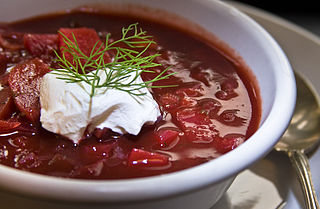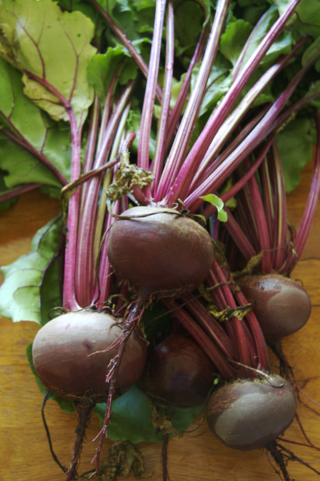
Tripe is a type of edible lining from the stomachs of various farm animals. Most tripe is from cattle, pigs and sheep.

Borscht is a sour soup, made with meat stock, vegetables and seasonings, common in Eastern Europe and Northern Asia. In English, the word borscht is most often associated with the soup's variant of Ukrainian origin, made with red beetroots as one of the main ingredients, which give the dish its distinctive red color. The same name, however, is also used for a wide selection of sour-tasting soups without beetroots, such as sorrel-based green borscht, rye-based white borscht, and cabbage borscht.

Offal, also called variety meats, pluck or organ meats, is the internal organs of a butchered animal. The word does not refer to a particular list of edible organs, and these lists of organs vary with culture and region, but usually exclude skeletal muscle. Offal may also refer to the by-products of milled grains, such as corn or wheat.

The beetroot or beet is the taproot portion of a Beta vulgaris subsp. vulgaris plant in the Conditiva Group. The plant is a root vegetable also known as the table beet, garden beet, dinner beet, or else categorized by color: red beet or golden beet. It is also a leaf vegetable called beet greens. Beetroot can be eaten raw, roasted, steamed, or boiled. Beetroot can also be canned, either whole or cut up, and often are pickled, spiced, or served in a sweet-and-sour sauce.

Polish cuisine is a style of food preparation originating in and widely popular in Poland. Due to Poland's history, Polish cuisine has evolved over the centuries to be very eclectic, and shares many similarities with other national cuisines. Polish cooking in other cultures is often referred to as à la polonaise.

Rémoulade is a cold sauce. Although similar to tartar sauce, it is often more yellowish, sometimes flavored with curry, and often contains chopped pickles or piccalilli. It can also contain horseradish, paprika, anchovies, capers and a host of other items.

Bigos, often translated into English as hunter's stew, is a Polish dish of chopped meat of various kinds stewed with sauerkraut, shredded fresh cabbage and spices. It is served hot and can be enriched with additional vegetables and wine. Originally from Poland, the dish also became traditional in the areas of the vast Polish–Lithuanian Commonwealth.

Smørrebrød, smørbrød "butter bread" (Norwegian), or smörgås " butter goose" (Swedish), is a traditional open-faced sandwich in the cuisines of Denmark, Norway and Sweden that usually consists of a piece of buttered rye bread, topped with commercial or homemade cold cuts, pieces of meat or fish, cheese or spreads, and garnishes.

Ragout is a stew served as a main dish.
Norwegian cuisine in its traditional form is based largely on the raw materials readily available in Norway. It differs in many respects from continental cuisine with a stronger focus on game and fish. Many of the traditional dishes are the result of using conserved materials because of the long winters.

Czech cuisine has both influenced and been influenced by the cuisines of surrounding countries and nations. Many of the cakes and pastries that are popular in Central Europe originated within the Czech lands. Contemporary Czech cuisine is more meat-based than in previous periods; the current abundance of farmable meat has enriched its presence in regional cuisine. Traditionally, meat has been reserved for once-weekly consumption, typically on weekends.

Pig's ear, as food for human consumption, is the cooked ear of pig. It is found in several cuisines around the world.

Venetian cuisine, from the city of Venice, Italy, or more widely from the region of Veneto, has a centuries-long history and differs significantly from other cuisines of northern Italy, and of neighbouring Austria and of Slavic countries, despite sharing some commonalities.

A meatball is ground meat (mince) rolled into a ball, sometimes along with other ingredients, such as bread crumbs, minced onion, eggs, butter, and seasoning. Meatballs are cooked by frying, baking, steaming, or braising in sauce. There are many types of meatballs using different types of meats and spices. The term is sometimes extended to meatless versions based on legumes, vegetables, mushrooms, fish or other seafood.

Chrain is a spicy paste made of grated horseradish. It is a common condiment for meat and fish dishes in Eastern and Central European cuisines. Chrain comes from Yiddish כריין, which is in turn a loanword from Slavic languages.

Indo cuisine is a fusion cooking and cuisine tradition, mainly existing in Indonesia and the Netherlands, as well as Belgium, South Africa and Suriname. This cuisine characterized of fusion cuisine that consists of original Indonesian cuisine with Eurasian-influences—mainly Dutch, also Portuguese, Spanish, French and British—and vice versa. Nowaday, not only Indo people consume Indo cuisine, but also Indonesians and Dutch people.


















